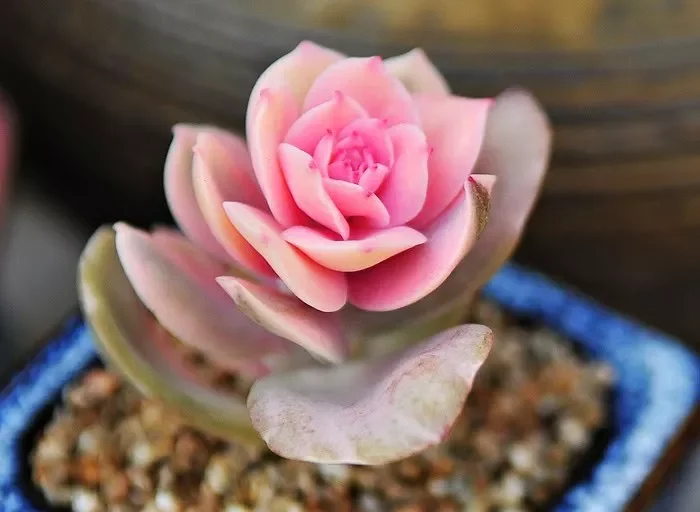Rosette succulents, with their captivating symmetry and resilience, have gained immense popularity among plant enthusiasts. Characterized by their compact, circular arrangement of leaves, these plants belong to various genera, including Echeveria, Sempervivum, and Aeonium. Their striking appearance and minimal care requirements make them ideal additions to both indoor and outdoor spaces. To ensure these beauties thrive and flourish, it’s essential to understand their specific care needs.
Essential Care Guidelines
1. Placement and Sunlight
Placement plays a crucial role in the health and vitality of rosette succulents. These plants thrive in bright, indirect sunlight. Indoors, place them near south or west-facing windows where they can receive ample sunlight without being exposed to direct rays for prolonged periods. Outdoors, choose a spot with partial shade, especially in regions with intense afternoon sun, to prevent sunburn.
2. Watering
One of the most common mistakes in succulent care is overwatering. Rosette succulents have adapted to store water in their leaves, making them susceptible to root rot if left in consistently damp soil. Water these plants sparingly, allowing the soil to dry out completely between waterings. In general, a thorough watering once every 7-10 days during the growing season (spring and summer) is sufficient. Reduce watering frequency in fall and winter when growth slows down.
3. Humidity
Rosette succulents prefer low to moderate humidity levels. Excessively humid conditions can promote fungal diseases and rot. Indoors, ensure good air circulation around the plants by using a fan if necessary. Avoid placing them near sources of moisture, such as bathrooms or kitchens. If you live in a humid climate, consider using a well-draining potting mix to mitigate the risk of moisture-related issues.
4. Temperature
Most rosette succulents thrive in temperatures ranging from 65°F to 80°F (18°C to 27°C) during the day and 50°F to 60°F (10°C to 15°C) at night. While they can tolerate occasional fluctuations, prolonged exposure to extreme heat or cold can cause stress and damage the plants. Protect them from frost during the winter months, either by bringing them indoors or providing adequate insulation.
5. Soil and Fertilization
Well-draining soil is essential for rosette succulents to prevent waterlogged conditions. Use a commercial cactus or succulent potting mix or create your own by adding perlite or coarse sand to regular potting soil. Fertilize sparingly during the growing season, typically from spring to early fall, using a balanced liquid fertilizer diluted to half strength. Avoid fertilizing during the dormant winter period.
6. Pruning and Shaping
Regular pruning helps maintain the shape and appearance of rosette succulents while promoting healthy growth. Remove any dead or damaged leaves by gently plucking them from the base. If the plant becomes leggy or elongated, prune back the stems to encourage compact growth. Use clean, sharp scissors or pruning shears to prevent unnecessary damage to the plant.
7. Repotting
As rosette succulents grow, they may outgrow their containers and require repotting. Typically, repotting is necessary every 1-2 years or when the plant appears crowded in its current pot. Choose a slightly larger container with adequate drainage holes and fill it with fresh potting mix. Carefully remove the plant from its old pot, gently loosen the roots, and place it in the center of the new container. Fill in the gaps with soil and water lightly to settle the plant.
Troubleshooting and Common Problems
Despite their resilience, rosette succulents are susceptible to a few common problems that can hinder their growth and appearance. Understanding these issues and addressing them promptly is key to maintaining healthy plants.
1. Overwatering: Signs of overwatering include mushy or translucent leaves, yellowing or wilting, and a foul odor emanating from the soil. If you suspect overwatering, allow the soil to dry out completely and adjust your watering schedule accordingly.
2. Underwatering: Conversely, underwatering can cause the leaves to become shriveled, wrinkled, or discolored. Increase watering frequency, ensuring that the soil is thoroughly moistened without becoming waterlogged.
3. Sunburn: Excessive exposure to direct sunlight can result in sunburn, characterized by brown or white patches on the leaves. Move the plant to a location with filtered light or provide shade during the hottest part of the day.
4. Pests: Common pests that may affect rosette succulents include aphids, mealybugs, and spider mites. Inspect the plant regularly for signs of infestation, such as webbing, sticky residue, or distorted growth. Treat affected plants with insecticidal soap or neem oil, ensuring thorough coverage of both the foliage and soil.
5. Disease: Fungal diseases, such as root rot and powdery mildew, can occur in excessively humid or poorly ventilated conditions. Improve air circulation around the plants, avoid overhead watering, and remove any affected leaves or stems promptly to prevent the spread of infection.
Conclusion
In conclusion, caring for rosette succulents involves providing them with the right balance of sunlight, water, and nutrients while protecting them from common pests and environmental stressors. By following these essential care guidelines and troubleshooting tips, you can enjoy healthy, vibrant succulents that add beauty and charm to any indoor or outdoor space.


